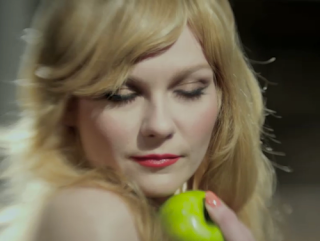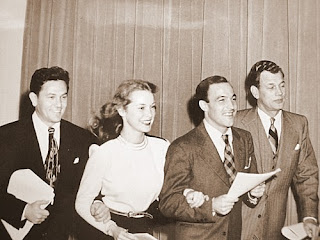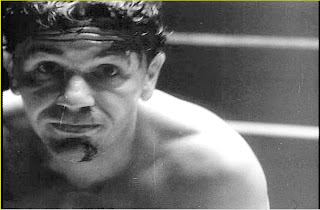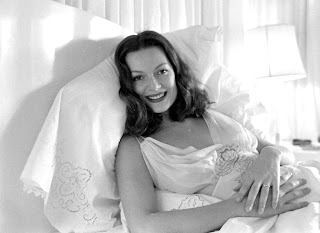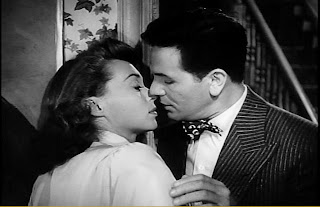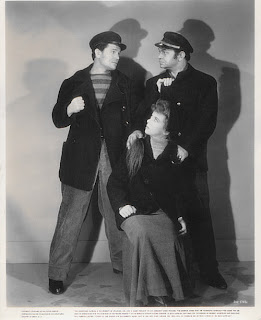 John Garfield, Ida Lupino and Edward G. Robinson in "The Sea Wolf" (1941) directed by Michael Curtiz
John Garfield, Ida Lupino and Edward G. Robinson in "The Sea Wolf" (1941) directed by Michael CurtizTHE SEA WOLF (1941): "Some of the more memorable sea captains include Captain Ahab in 'Moby Dick', Captain Bligh in 'Mutiny on the Bounty', and Captain Queeg in 'The Caine Mutiny' (played by Bogart). But none of these misguided authority figures can match the sadism and brutality of Wolf Larsen, the megalomaniac captain of Jack London's novel, 'The Sea Wolf'. Larsen is a fascinating enigma - a mystic and a philosopher but also a dangerous manic-depressive who subjects his crew to outrageous acts of cruelty; at one point, Larsen decides to give the ship's cook a bath by towing him in the schooner's wake - an action that results in the cook losing his foot to a shark.
 Sylvia Sidney and Humphrey Bogart in "The Wagons Roll at Night" (1941) directed by Ray Enright
Sylvia Sidney and Humphrey Bogart in "The Wagons Roll at Night" (1941) directed by Ray EnrightMichael Curtiz tried to draft Humphrey Bogart for the part but he was committed to another picture ('The Wagons Roll at Night') so John Garfield, who had made his screen debut in 'Four Daughters' (1938), also directed by Curtiz, was tapped for the role.
 It was a personal triumph for John Garfield who counted Jack London among his favorite authors but it was an even bigger honor for Edward G. Robinson who had been a fan of the novel since he first read it at age eleven.
It was a personal triumph for John Garfield who counted Jack London among his favorite authors but it was an even bigger honor for Edward G. Robinson who had been a fan of the novel since he first read it at age eleven. In his autobiography, 'All My Yesterdays', Edward G. Robinson recalled: "I had no idea at the time that the domineering Captain Wolf Larsen was to be characterized by critics as a Nietzsche superman; I just considered him to be a wonderful character. And that's how I played him, with John Garfield playing George Leach.
In his autobiography, 'All My Yesterdays', Edward G. Robinson recalled: "I had no idea at the time that the domineering Captain Wolf Larsen was to be characterized by critics as a Nietzsche superman; I just considered him to be a wonderful character. And that's how I played him, with John Garfield playing George Leach. John Garfield was one of the best young actors I ever encountered, but his passions about the world were so intense that I feared any day he would have a heart attack. It was not long before he did."
John Garfield was one of the best young actors I ever encountered, but his passions about the world were so intense that I feared any day he would have a heart attack. It was not long before he did." George Leach, who was drowned in the original novel, becomes the central love interest in this version, escaping to safety with Ruth Webster. All of these changes actually strengthened the film on a dramatic level and were further enhanced by Sol Polito's atmospheric cinematography and Anton Grot's art direction - both heavily influenced by the look of German Expressionist cinema". Source: www.tcm.com
George Leach, who was drowned in the original novel, becomes the central love interest in this version, escaping to safety with Ruth Webster. All of these changes actually strengthened the film on a dramatic level and were further enhanced by Sol Polito's atmospheric cinematography and Anton Grot's art direction - both heavily influenced by the look of German Expressionist cinema". Source: www.tcm.comFilm Noir and Existencialism:
 Burt Lancaster and Ava Gardner in "The Killers" (1946) directed by Robert Siodmak, based on a short story written by Ernest Hemingway. The prototypic Hemingway hero must face evil, futility, and the nothingness of existence alone and unaided. Defeat is inevitable and unavoidable; only defeat with dignity offers hope of redemption.
Burt Lancaster and Ava Gardner in "The Killers" (1946) directed by Robert Siodmak, based on a short story written by Ernest Hemingway. The prototypic Hemingway hero must face evil, futility, and the nothingness of existence alone and unaided. Defeat is inevitable and unavoidable; only defeat with dignity offers hope of redemption. Arthur Schopenhauer cited those very features of the human condition that pessimism takes as its point of departure: “The vanity of existence is revealed in the whole form existence assumes... in the contingency and relativity of all things; in continual becoming without being; in continual desire without satisfaction; in the continual frustration of striving of which life consists.”
Arthur Schopenhauer cited those very features of the human condition that pessimism takes as its point of departure: “The vanity of existence is revealed in the whole form existence assumes... in the contingency and relativity of all things; in continual becoming without being; in continual desire without satisfaction; in the continual frustration of striving of which life consists.” Schopenhauer presents a “moral” critique, one that fastens on the vanity of human wishes, on the spectacle of human folly and wickedness, and, more ominously, on the ill will, malice, and cruelty of other people, whom Schopenhauer likens to a “den of sharks and swindlers.” As Jean-Paul Sartre writes in 'Being and Nothingness': “For human reality, to be is to choose oneself.”
Schopenhauer presents a “moral” critique, one that fastens on the vanity of human wishes, on the spectacle of human folly and wickedness, and, more ominously, on the ill will, malice, and cruelty of other people, whom Schopenhauer likens to a “den of sharks and swindlers.” As Jean-Paul Sartre writes in 'Being and Nothingness': “For human reality, to be is to choose oneself.” “How do you get through nights if you can’t sleep? I guess you find out like you find out how it feels to lose your husband. I guess you find out all right. I guess you find out everything in this goddamned life. I guess you do all right. I guess I’m probably finding out right now. You just go dead inside and everything is easy. You just get dead like most people are most of the time. I guess that’s how it is all right. I guess that’s just about what happens to you. Well, I’ve got a good start. I’ve got a good start if that’s what you have to do. I guess that’s what you have to do all right. I guess that’s it. I guess that’s what it comes to. All right. I got a good start then. I’m way ahead of everybody now.” -To Have and Have Not (1937) novel by Ernest Hemingway
“How do you get through nights if you can’t sleep? I guess you find out like you find out how it feels to lose your husband. I guess you find out all right. I guess you find out everything in this goddamned life. I guess you do all right. I guess I’m probably finding out right now. You just go dead inside and everything is easy. You just get dead like most people are most of the time. I guess that’s how it is all right. I guess that’s just about what happens to you. Well, I’ve got a good start. I’ve got a good start if that’s what you have to do. I guess that’s what you have to do all right. I guess that’s it. I guess that’s what it comes to. All right. I got a good start then. I’m way ahead of everybody now.” -To Have and Have Not (1937) novel by Ernest Hemingway Patricia Neal as Leona Charles and Phyllis Thaxter as Lucy Morgan in "The Breaking Point" (1950) directed by Michael Curtiz
Patricia Neal as Leona Charles and Phyllis Thaxter as Lucy Morgan in "The Breaking Point" (1950) directed by Michael Curtiz "The Breaking Point" was based on the Ernest Hemingway novel's "To Have and Have Not". A movie with that title, in 1944, was generally thought to be the film version of the book, but William Faulkner -who disliked Hemingway- wrote an original script, keeping only the title and the name of the lead character.
"The Breaking Point" was based on the Ernest Hemingway novel's "To Have and Have Not". A movie with that title, in 1944, was generally thought to be the film version of the book, but William Faulkner -who disliked Hemingway- wrote an original script, keeping only the title and the name of the lead character. Humphrey Bogart as Harry Morgan and Lauren Bacall as Marie 'Slim' in "To Have and Have Not" (1944) directed by Howard Hawks
Humphrey Bogart as Harry Morgan and Lauren Bacall as Marie 'Slim' in "To Have and Have Not" (1944) directed by Howard Hawks It was the movie that introduced Lauren Bacall to both the screen and Humphrey Bogart. Our film was, in fact, a very faithful version of the novel. Hemingway glanced up and winked at me. "I write goddamned good books, you know!" I knew he liked me. He told me he thought 'The Breaking Point' was the best film made from any of his books.
It was the movie that introduced Lauren Bacall to both the screen and Humphrey Bogart. Our film was, in fact, a very faithful version of the novel. Hemingway glanced up and winked at me. "I write goddamned good books, you know!" I knew he liked me. He told me he thought 'The Breaking Point' was the best film made from any of his books. I played a loose woman who is mixed up with gun runners and John Garfield, whom I lure away from his wife, played by the delicious Phyillis Thaxter. In the end John goes back to Phyllis and I get what I deserve. My last lines in the film still give me a kick: 'I guess I sould have swam back to port. Or is it swum?'
I played a loose woman who is mixed up with gun runners and John Garfield, whom I lure away from his wife, played by the delicious Phyillis Thaxter. In the end John goes back to Phyllis and I get what I deserve. My last lines in the film still give me a kick: 'I guess I sould have swam back to port. Or is it swum?' John Garfield always projected a strong male animal quality in his films. It was not an act. He had an eye for the ladies and did not waste time. 'I want to talk to you', he commanded when we met. 'You know, you're a whore?' I looked at him aghast. 'In the picture I mean. You are all whore'. He took my hand and smiled ever so slightly. 'You know what I mean? You understand me?' I understood exactly what he meant. -"As I Am: An Autobiography" by Patricia Neal
John Garfield always projected a strong male animal quality in his films. It was not an act. He had an eye for the ladies and did not waste time. 'I want to talk to you', he commanded when we met. 'You know, you're a whore?' I looked at him aghast. 'In the picture I mean. You are all whore'. He took my hand and smiled ever so slightly. 'You know what I mean? You understand me?' I understood exactly what he meant. -"As I Am: An Autobiography" by Patricia Neal John Garfield played Hemingway's hero Harry Morgan in "The Breaking Point" (1950)
John Garfield played Hemingway's hero Harry Morgan in "The Breaking Point" (1950) "Patricia Neal displays her smarts and sensitivity. In Michael Curtiz’s 'The Breaking Point' (1950), opposite the great John Garfield, Neal gives my favorite of her performances, as a high-class whore. She is not only slinky, bad-girl fun in the part, but she gives this familiar “tramp” type a penetrating depth and humanity. Plus, her chemistry with Garfield is electric". Source: screensaversmovies.com
"Patricia Neal displays her smarts and sensitivity. In Michael Curtiz’s 'The Breaking Point' (1950), opposite the great John Garfield, Neal gives my favorite of her performances, as a high-class whore. She is not only slinky, bad-girl fun in the part, but she gives this familiar “tramp” type a penetrating depth and humanity. Plus, her chemistry with Garfield is electric". Source: screensaversmovies.com

